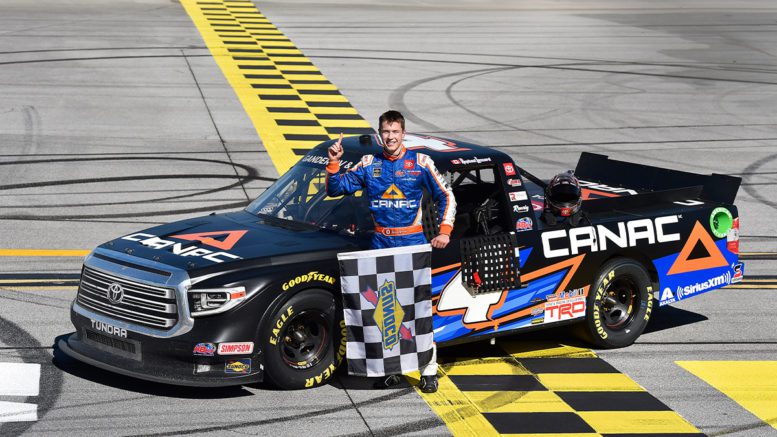Quebec’s Raphaël Lessard looked as though his future in NASCAR series racing was secured when he took the checkered flag in a truck race at the famous Talladega Superspeedway back in 2020.
The talented teenager, now 20, missed most of the 2021 season due to a lack of funding.
Lessard, who drove for Kyle Busch Motorsports in 2020, spoke on his decision to move to GMS Racing for 2021 and the struggles he’s had to face.
“Kyle Busch Motorsports is known as one of the most expensive team in the truck series,” said Lessard in an interview with the Observer. “So we just couldn’t do another season at that price.
“Going to GMS was going to help that, but then we just couldn’t do it anymore because it’s been so hard trying to get sponsors, whether from Canada or United States. It just been really hard especially with the virus.”
It’s a similar story for so many young Canadians, and one of the main reasons for the lack of drivers from this country in the biggest American series.
Out of the 93 Canadians that have made an appearance in NASCAR’s national series, only 42 have made a Cup series start and just 10 have reached the double-digit mark with the lone win coming from Earl Ross at the 1974 Old Dominion 500 at Martinsville Speedway.
Those involved say the difficulties are numerous.
Veteran auto racing writer Norris McDonald says a lack of tracks in Canada compared to those throughout the U.S. and on the NASCAR schedule is a major reason our drivers are on the back foot.
“Most of the Cup races are oval tracks,” said McDonald, to the Observer. “We do not have anywhere in Canada a large oval track on which to race.
“There’s a bunch of little ovals, five-eighths mile and half a mile tracks. But there isn’t a big oval on which these guys can cut their teeth, which is not the case in the United States.”
Lessard echoed the same sentiment when talking about the biggest adjustment he had to make when entering the truck series.
“All I was doing is short track racing,” Lessard said. “And now I was racing on superspeedways, mile and a half, two-mile racetracks, very big racetrack where all the aero side of racing was really, really big. And it was something pretty hard to get used to.”
This leaves Canadians heading into the national series down a cylinder, so to speak.

Coupled with this hurdle is the problem of sponsorship, which doesn’t just involve the dollar values, according to Erik Tomas of Raceline Radio Network.
“Let’s remember … when the driver comes in, he’s not only driving the car but he’s also now a major cog in the marketing effort,” Tomas said. “The idea is for a company is to sell more product, and they’ll do that with exposure on the side of a race car, on a race track on a Sunday in NASCAR at various tracks across the USA.
“In theory, will they sell more with an American driver at the wheel or with a Canadian driver at the wheel? The answer is going to be an American driver almost every time unless the Canadian driver is such an exemplary talent and is head, hands, and feet above most drivers out there.”
Alongside this, is what he says is an insular culture within stock car racing south of the border.
“American stock car racing teams are always going to hire American drivers, who have come up through the system racing primarily on American tracks through the American development system,” says Tomas. “And the Canadian is going to go down there and try to latch on.
“Yeah, you can buy your way in. But that doesn’t always work.”
These factors mean that American drivers will most likely have increased marketability from the start, which is quantified by what is known as a Q Score. To put it simply, this value measures the popularity and familiarity of a brand, item, celebrity or entertainment product.
Canadian drivers will have a lower Q Score, making them less attractive to sponsors and teams, helping create the difficult path that they have in front of them.
But that doesn’t mean that it is impossible, and there may be more chances coming for drivers to get their foot in the door.
This year, the Cup series held its most road course races in a single calendar with seven. With NASCAR’s continued push to diversify their calendar and possibly looking to add street courses in the near future, there will continue to be more opportunities for Canadian drivers to get a chance at the top flight, especially with the road racing proficiency that they bring.
In the meantime, there are some Canadians that are currently making their name in the NASCAR national series
Stewart Friesen, from Niagara-on-the-Lake, Ontario, is a full-time driver as well as owner of Halmar Friesen Racing in the Camping World Truck Series and is coming off a season that featured an appearance in the round of eight of the NASCAR Playoffs.
Alex Labbé from Saint-Albert, Que., is currently running full-time in the Xfinity series with DGM Racing and is coming off a season with three top 10s, coming 19th in the points, and an average finish position of 22.4.

